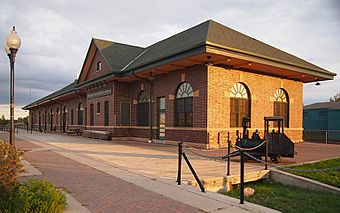Bemidji station facts for kids
Quick facts for kids |
|
|
Great Northern Depot
|
|

Bemidji's Great Northern Depot viewed from the northwest
|
|
| Location | 130 Minnesota Avenue SW, Bemidji, Minnesota |
|---|---|
| Area | Less than one acre |
| Built | 1912–13 |
| Architectural style | Neoclassical/Arts and Crafts |
| NRHP reference No. | 88000673 |
| Designated | May 26, 1988 |
The Bemidji station was once a busy train station for the Great Northern Railway in Bemidji, Minnesota. It opened in 1913, taking the place of an older wooden building. This station was special because it was the very last one ordered by a famous railroad leader named James J. Hill.
The station served passengers until the late 1950s. It then became a place for shipping goods until the mid-1980s. After that, it was closed and left empty.
In 1988, the station was added to the National Register of Historic Places. It was recognized as the Great Northern Depot because it was important to Bemidji's history. It showed how railroads helped the town grow from a small settlement into a busy logging town and a major trading center.
For a while, the building was empty and falling apart. People even planned to tear it down. But thanks to a big effort and nearly $2 million, the building was saved! Today, it is home to the Beltrami County History Center, run by the Beltrami County Historical Society.
What Does the Station Look Like?
The Great Northern Depot is a one-story building. It is made of brick and limestone. The roof is shaped like a hip, which means it slopes down on all four sides.
The building's style is mostly Neoclassical. You can see this in its arched windows, doors, and the front of the building. But it also has parts that look like the Arts and Crafts style. This is clear in the wide eaves (the parts of the roof that hang over the walls) and the way the windows are designed.
Inside, the building is about 7,000 square feet (650 square meters). It used to have separate waiting areas for men and women. Both waiting rooms had long benches called settees. The ladies' room even had several rocking chairs.
In the middle of the building was the ticket office. The east end had rooms for luggage and freight (goods being shipped). A small, windowed area on the south side allowed workers to see the train tracks in both directions. All the electrical wires were hidden at the back of the building. This was done so they wouldn't spoil the building's nice appearance.
Why Was a New Station Built?
Bemidji's first Great Northern Depot was made of wood. It was built in 1898 and made bigger in 1901. Electricity was added in 1903, and a baggage room in 1905. But the old station was still too small.
By 1907, a local group called the Bemidji Commercial Club started asking for a new station. The old one was too small, didn't have good airflow, and couldn't handle all the people and goods coming through Bemidji.
In June 1911, people kept asking the Great Northern Railway for a new station. The governor, Adolph Olson Eberhart, and Louis W. Hill visited Bemidji. Louis Hill was the president of the railway and the son of James J. Hill. The Bemidji Commercial Club invited them to dinner and took them on a boat ride around Lake Bemidji. After that, local business leaders rode with Louis Hill in his private train car to talk more.
In January 1912, James J. Hill himself came to Bemidji. He was the head of the Great Northern Railway. He gave a speech and was entertained by the Commercial Club.
On April 25, 1912, the Bemidji Daily Pioneer newspaper announced exciting news: "Hill Promises a New Brick Building." Work was supposed to start right away. The plans from the year before were looked at again. They were for a very expensive "Permanent Type A depot," usually built for towns with 20,000 or more people.
But when James Hill visited Bemidji, he saw an impressive new brick station nearby. It belonged to the Minnesota and International Railway. He said, "We will build a depot and a good one." So, the original plans were approved. The new station would be 217 feet (66 meters) long and 7,000 square feet (650 square meters). It would have a red brick and sandstone outside.
Most of the work on the station was finished by the end of 1912. Thousands of people toured the new station for its grand opening on January 16, 1913. James Hill returned to Bemidji for the opening. He told the crowd that he had taken special care with this station. He said it would be his last one.
The Station Becomes a History Center
The Great Northern Depot served passengers until the late 1950s. It continued as a freight station until the mid-1980s. Then, it was closed, boarded up, and left empty. Even though it was added to the National Register of Historic Places in 1988, the building had no one to take care of it. Water leaked in, vandals caused damage, and pigeons, bats, and rodents moved in.
The railroad company, which was then the Burlington Northern Railroad, wanted to tear down the building. But thanks to a railroad superintendent named Roger Mackenroth, the demolition was stopped. A dedicated Historical Society Museum Committee worked hard to raise money. They also got a state bill for $650,000. Because of these efforts, the building was saved and fixed up. The renovation cost nearly two million dollars.
The station reopened in October 2000. It became the new home of the Beltrami County Historical Society. The train tracks next to the building are still used today by the BNSF Railway.



